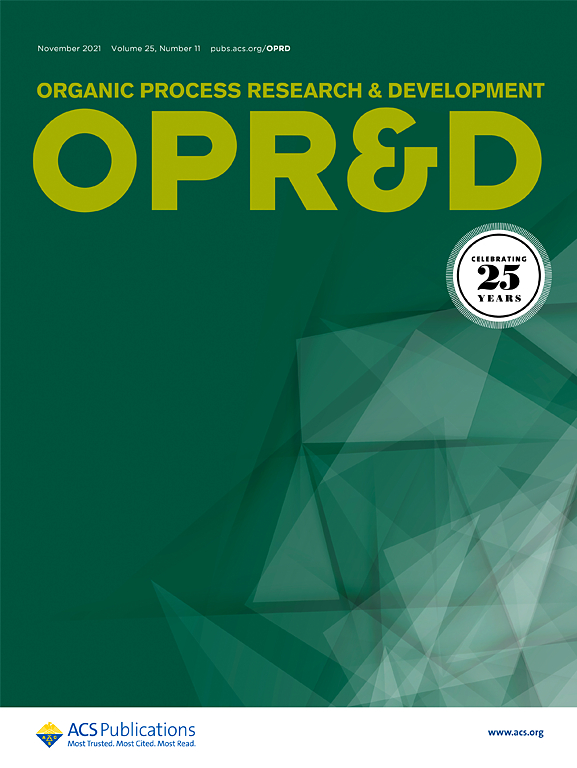在线膜相分离连续流法制备三氟甲基重氮甲烷──在取代苯乙烯催化不对称环丙烷化中的应用
IF 3.5
3区 化学
Q2 CHEMISTRY, APPLIED
引用次数: 0
摘要
三氟甲基重氮甲烷(TFDM)是一种用途广泛的有机合成试剂和药物化学试剂。TFDM的应用受到规模安全问题的阻碍。本文报道了一种在流动中生成干燥、无酸的TFDM浓缩溶液的新方法。在流动方案中包含一个在线液-液相分离器是一个关键组成部分。所得到的干流可以耦合到含有手性钌催化剂和苯乙烯底物的反应器中,在塞流反应器-批处理中对映选择性地构建反式三氟甲基取代环丙烷。该系统被用来获得各种对映体富集的反式三氟甲基取代环丙烷。本文章由计算机程序翻译,如有差异,请以英文原文为准。

Continuous Preparation of Trifluoromethyl Diazomethane in Flow Using In-Line Membrane Phase Separation─Application to the Catalytic Asymmetric Cyclopropanation of Substituted Styrenes
Trifluoromethyl diazomethane (TFDM) is a versatile reagent in organic synthesis and medicinal chemistry efforts. The utility of TFDM is hampered by safety concerns on scale. A novel method for the generation of dry, acid-free concentrated solutions of TFDM in a flow is reported here. The inclusion of an in-line liquid–liquid phase separator was a critical component in the flow scheme. The resulting dry stream could be coupled to a reactor containing a chiral ruthenium catalyst and styrene substrate to enantioselectively construct trans-trifluoromethyl-substituted cyclopropanes in a plug flow reactor–batch train. This system was utilized to access a variety of enantioenriched trans-trifluoromethyl-substituted cyclopropanes.
求助全文
通过发布文献求助,成功后即可免费获取论文全文。
去求助
来源期刊
CiteScore
6.90
自引率
14.70%
发文量
251
审稿时长
2 months
期刊介绍:
The journal Organic Process Research & Development serves as a communication tool between industrial chemists and chemists working in universities and research institutes. As such, it reports original work from the broad field of industrial process chemistry but also presents academic results that are relevant, or potentially relevant, to industrial applications. Process chemistry is the science that enables the safe, environmentally benign and ultimately economical manufacturing of organic compounds that are required in larger amounts to help address the needs of society. Consequently, the Journal encompasses every aspect of organic chemistry, including all aspects of catalysis, synthetic methodology development and synthetic strategy exploration, but also includes aspects from analytical and solid-state chemistry and chemical engineering, such as work-up tools,process safety, or flow-chemistry. The goal of development and optimization of chemical reactions and processes is their transfer to a larger scale; original work describing such studies and the actual implementation on scale is highly relevant to the journal. However, studies on new developments from either industry, research institutes or academia that have not yet been demonstrated on scale, but where an industrial utility can be expected and where the study has addressed important prerequisites for a scale-up and has given confidence into the reliability and practicality of the chemistry, also serve the mission of OPR&D as a communication tool between the different contributors to the field.

 求助内容:
求助内容: 应助结果提醒方式:
应助结果提醒方式:


